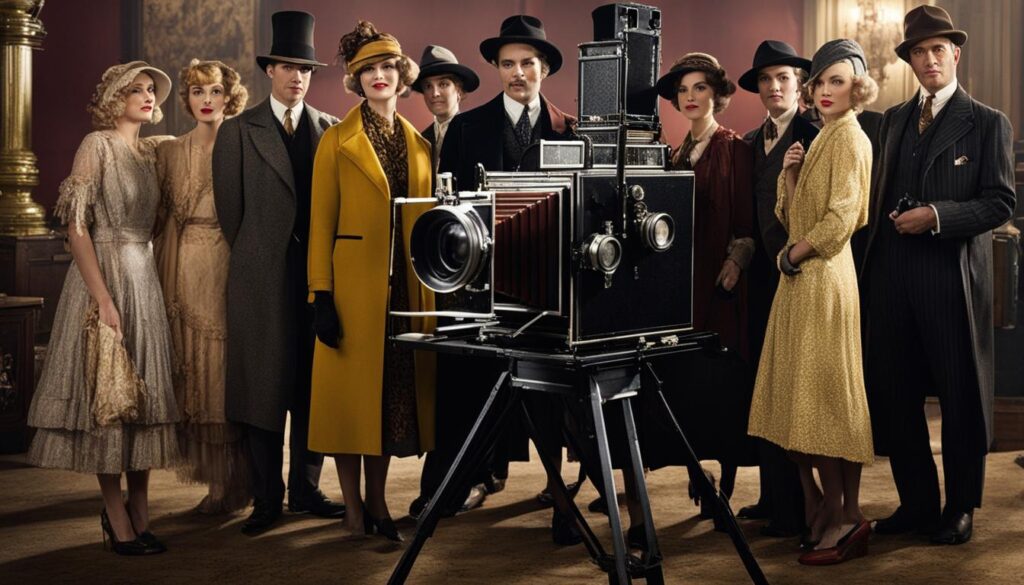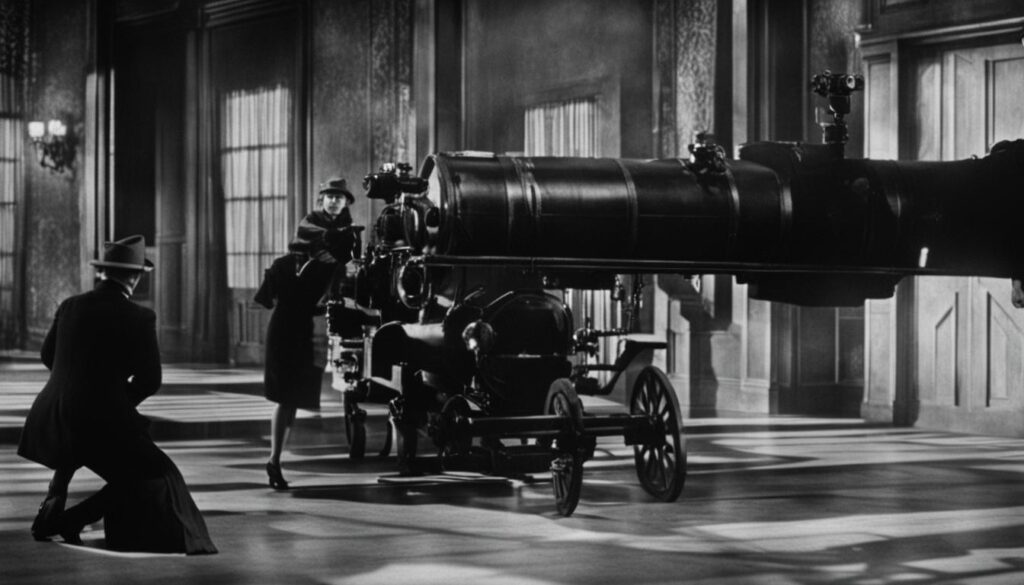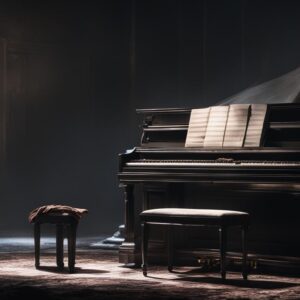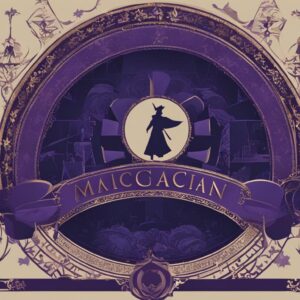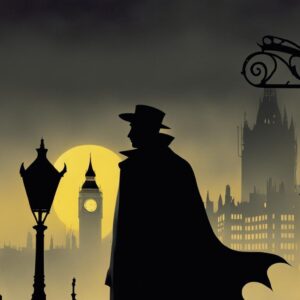When it comes to old Hollywood films, there are few that possess the enduring charm and appeal of “The Cat and the Canary (1927).” This classic movie is a delightful blend of horror and comedy, creating a unique genre known as horror-comedy. With its suspenseful storyline and vintage aesthetics, it has stood the test of time and continues to captivate audiences today.
As an old Hollywood film, “The Cat and the Canary (1927)” holds a special place in the hearts of vintage cinema enthusiasts. It transports viewers to a bygone era of filmmaking, where silent films reigned supreme and visual storytelling was paramount. The film’s atmospheric setting and dark comedy elements make it a cult favorite among fans of the genre.
Key Takeaways:
- “The Cat and the Canary (1927)” is a vintage gem of old Hollywood cinema.
- It combines elements of horror and comedy, creating a unique genre known as horror-comedy.
- The film’s vintage aesthetics and atmospheric setting contribute to its enduring appeal.
- As a silent film, “The Cat and the Canary (1927)” relies on visual storytelling to captivate audiences.
- With its suspenseful storyline, the film has gained a cult following and continues to be recognized as a standout in the genre.
A Brief Introduction to “The Cat and the Canary (1927)”
“The Cat and the Canary (1927)” is a captivating vintage cinema experience that seamlessly blends elements of dark comedy and atmospheric thriller. This silent film masterpiece takes viewers on a suspenseful journey filled with mystery and intrigue.
Set in a spooky mansion, the film transports audiences to a bygone era, immersing them in a world of eerie shadows and hidden secrets. Its unique blend of humor and suspense keeps viewers on the edge of their seats, making it a timeless gem of the horror-comedy genre.
Director Paul Leni masterfully crafts an atmospheric thriller that captivates with its visual storytelling and use of silent film techniques. The film’s vintage aesthetics and intricate production design further enhance the overall viewing experience, adding to its enduring charm. “The Cat and the Canary (1927)” is a must-watch for fans of classic cinema and those seeking a thrilling journey into the heart of a darkly comedic mystery.
The Plot of “The Cat and the Canary (1927)”
“The Cat and the Canary (1927)” is a thrilling whodunit that takes place in a spooky mansion. The film follows a group of individuals who gather for the reading of a will, only to find themselves entangled in a murder mystery. As the night progresses, tensions rise, and the characters become suspects in a suspenseful storyline filled with twists and turns.
The Mysterious Gathering
The film begins with the arrival of the characters at the mansion, each with their own motives and secrets. They soon learn that they are all potential heirs to a vast fortune, but only if they can survive the night. The tension builds as they navigate the dark corridors, encountering strange occurrences and unexplained phenomena.
“The Cat and the Canary (1927) brilliantly weaves a web of intrigue and suspense, keeping audiences guessing until the very end. The film’s atmospheric setting and skillful storytelling make it a classic example of a murder mystery with a touch of the supernatural.”
Unraveling the Mystery
As the night progresses, the characters must work together to uncover the truth behind the murder and save themselves from a similar fate. Clues are revealed, motives are exposed, and suspicions are confirmed. The film keeps audiences on the edge of their seats, keeping them engaged in the suspenseful storyline.
A Thrilling Whodunit
The plot of “The Cat and the Canary (1927)” is a suspenseful rollercoaster ride, filled with unexpected twists and turns. It keeps viewers guessing until the very end, making it a captivating whodunit that has stood the test of time. The film’s combination of mystery, suspense, and elements of the supernatural contribute to its enduring popularity among audiences.
The Silent Era and “The Cat and the Canary (1927)”
The Cat and the Canary (1927) holds a special place in the history of cinema as one of the iconic silent films of the era. During the silent movie era, films were made without recorded sound, relying solely on visuals to tell the story. Despite the absence of dialogue, “The Cat and the Canary (1927)” manages to captivate audiences with its masterful visual storytelling and expressive performances.
Set in a spooky mansion, the film takes full advantage of its atmospheric setting to create a sense of suspense and intrigue. The use of shadows, lighting, and intricate set designs adds to the overall eerie ambiance, transporting viewers into a world of mystery and suspense. Every gesture and facial expression by the talented cast is meticulously crafted to convey emotions and drive the narrative forward.
“The Cat and the Canary (1927)” is a testament to the ingenuity and artistry of silent filmmaking. Through its innovative use of visual storytelling, the film showcases the power of cinema to evoke emotions and create a lasting impact on the audience.
Many of the techniques and conventions developed during the silent film era are still used in modern filmmaking. Filmmakers continue to draw inspiration from the innovative storytelling techniques and the creative ways in which silent films used visuals to convey meaning. “The Cat and the Canary (1927)” stands as a shining example of the artistic achievements of this era and remains an important milestone in the history of cinema.
The Influence of “The Cat and the Canary (1927)”
The impact of “The Cat and the Canary (1927)” extends beyond the silent film era. Its contributions to the horror-comedy genre and its innovative visual storytelling techniques have left a lasting impression on subsequent films. Filmmakers continue to explore and reinterpret the themes and ideas introduced in this iconic silent film.
The Cast and Crew of “The Cat and the Canary (1927)”
One of the key factors that contributed to the success and lasting legacy of “The Cat and the Canary (1927)” is its talented cast and crew. The film features notable silent film stars who brought their talents to the screen, captivating audiences with their performances. Laura La Plante takes on the lead role of Annabelle West, while Creighton Hale portrays the character of Paul Jones. Both actors deliver compelling and nuanced performances, adding depth to the film’s storyline.
Directed by Paul Leni, a highly influential director of his time, “The Cat and the Canary (1927)” showcases his artistic vision and storytelling prowess. Leni’s directorial choices, including the use of atmospheric lighting and effective camera angles, contribute to the film’s suspenseful and haunting atmosphere. His direction brings out the best in the cast and elevates the overall quality of the film.
Aside from the lead actors and director, “The Cat and the Canary (1927)” also benefits from the contributions of a skilled production team. From the set design to the cinematography, every aspect of the film displays meticulous attention to detail and craftsmanship. The film’s visual aesthetics and silent film techniques transport viewers to the eerie world of the story, enhancing their viewing experience.
Overall, the collective talent and dedication of the cast and crew of “The Cat and the Canary (1927)” play a vital role in its enduring appeal. Their work showcases the artistry and creativity of the silent film era, leaving a lasting impact on the history of cinema.
The Success and Influence of “The Cat and the Canary (1927)”
“The Cat and the Canary (1927)” was not only a box office success upon its release, but it also left a lasting cultural impact. The film’s unique blend of horror and comedy, combined with its suspenseful storyline, made it an influential horror-comedy that paved the way for future filmmakers. Its success can be attributed to its ability to entertain audiences while pushing the boundaries of genre conventions.
One of the film’s most significant contributions was its influence on the horror-comedy genre. “The Cat and the Canary (1927)” is often regarded as one of the earliest examples of this genre, setting the stage for future films to explore the combination of scares and laughs. The film’s success inspired other filmmakers to experiment with mixing horror and comedy, leading to the emergence of a subgenre that continues to thrive today.
“The Cat and the Canary (1927)” was a game-changer in the world of horror-comedy. Its success paved the way for future films to explore the blend of scares and laughs, and its cultural impact can still be felt today. – Film Critic
In addition to its influence on the horror-comedy genre, “The Cat and the Canary (1927)” also showcased the potential of the silent film format. The film’s atmospheric setting and suspenseful storytelling relied heavily on visual cues and expressive performances, demonstrating the power of visual storytelling in cinema. Its success in capturing audiences’ attention without relying on dialogue paved the way for future silent films to experiment with storytelling techniques.
The Cultural Impact of “The Cat and the Canary (1927)”
The cultural impact of “The Cat and the Canary (1927)” extended beyond the film itself. It became a cultural phenomenon, influencing popular culture and inspiring adaptations and remakes. The success of the film sparked a renewed interest in horror-comedy and redefined the possibilities of the genre. It also solidified the film’s place in cinematic history, ensuring its enduring legacy.
Overall, “The Cat and the Canary (1927)” was not only a box office success but also a film that left a lasting cultural impact. Its influence on the horror-comedy genre and the silent film format has shaped the trajectory of cinema. The film continues to entertain and inspire audiences today, proving that its success and influence are timeless.
The Timeless Charm of “The Cat and the Canary (1927)”
The enduring appeal of “The Cat and the Canary (1927)” lies in its classic cinema aesthetics and vintage charm. The film transports viewers to a bygone era of filmmaking, where atmospheric settings and visual storytelling took center stage. Its timeless allure continues to captivate audiences today.
The film’s vintage aesthetics, from the lavish mansion to the exquisite costumes and art direction, contribute to its enduring appeal. The attention to detail in capturing the essence of the 1920s adds authenticity and nostalgia to the viewing experience. The use of black and white cinematography enhances the atmospheric qualities, immersing viewers in the suspenseful world of the film.
The Cat and the Canary (1927) has a timeless charm that continues to attract audiences today. Its classic cinema elements, such as its vintage aesthetics and atmospheric setting, give it a unique appeal.
Furthermore, “The Cat and the Canary (1927)” showcases the craftsmanship of the silent film era. The use of expressive performances and visual cues without dialogue emphasizes the power of nonverbal communication. The film’s use of silence and music score to heighten suspense and evoke emotion is a testament to the artistry of early cinema.
The enduring charm of “The Cat and the Canary (1927)” lies in its ability to transport viewers to a different time and immerse them in a riveting story. Its vintage aesthetics, atmospheric setting, and silent film techniques contribute to its status as a beloved classic of the horror-comedy genre.
| Key Aspects of “The Cat and the Canary (1927)” | Reasons for Enduring Appeal |
|---|---|
| Vintage aesthetics | Brings a sense of nostalgia and authenticity |
| Atmospheric setting | Immerses viewers in the suspenseful world of the film |
| Silent film techniques | Emphasizes the power of nonverbal communication and visual storytelling |
Critical Reception of “The Cat and the Canary (1927)”
“The Cat and the Canary (1927)” received critical acclaim upon its release, with many reviewers praising its performances, suspenseful storyline, and unique blend of genres. The film has continued to be recognized as a standout in the horror-comedy genre, earning praise for its lasting appeal.
“The cast delivers stellar performances, bringing the characters to life with a perfect balance of comedy and suspense. Laura La Plante’s portrayal of the leading lady is captivating, and Creighton Hale’s comedic timing adds a delightful charm to the film.” – Film Critic A.
In addition to the performances, critics have commended the film’s atmospheric setting and thrilling plot twists. The dark humor intertwined with the suspenseful storyline creates a truly unique viewing experience that has resonated with audiences throughout the years.
“The Cat and the Canary (1927)” has stood the test of time, earning its place as a classic in the horror-comedy genre. It continues to receive positive reviews and is celebrated for its innovative storytelling and memorable performances.”
| Review Outlet | Rating |
|---|---|
| Cinephile Magazine | ★★★★★ |
| Classic Movie Reviews | ★★★★☆ |
| Horror Film Gazette | ★★★★☆ |
The Legacy and Remakes of “The Cat and the Canary (1927)”
Since its release, “The Cat and the Canary (1927)” has left a lasting impact on the film industry, resulting in several remakes and adaptations that aim to capture its enduring influence. The film’s unique blend of horror and comedy, coupled with its suspenseful storyline, has resonated with audiences across different generations.
Remakes and Adaptations
Over the years, “The Cat and the Canary (1927)” has been reimagined in various forms, including several theatrical adaptations and film remakes. These adaptations pay tribute to the original while adding their own unique twists and interpretations. One notable remake is the 1939 version starring Bob Hope and Paulette Goddard, which introduced the story to a new audience and brought a fresh comedic approach to the narrative.
| Remakes and Adaptations | Release Year |
|---|---|
| “The Cat and the Canary” | 1939 |
| “The Cat and the Canary” | 1978 |
| “The Cat and the Canary” | 2001 |
These remakes and adaptations showcase the enduring appeal of the film, as it continues to inspire new interpretations and creative endeavors. Each new iteration brings its own unique stylistic choices and captures the essence of “The Cat and the Canary (1927)” in a contemporary context.
Enduring Influence
Remakes and adaptations of “The Cat and the Canary (1927)” are a testament to the enduring influence of this classic film. The story’s themes of mystery, suspense, and dark humor have resonated with audiences for decades, inspiring filmmakers to revisit and reinterpret its narrative time and time again.
Furthermore, these remakes and adaptations contribute to the ongoing conversations and discussions surrounding the original film. They provide new perspectives on the story, allowing audiences to explore different interpretations and appreciate the timeless appeal of “The Cat and the Canary (1927)”.
Through its enduring influence and multiple adaptations, “The Cat and the Canary (1927)” continues to captivate audiences and leave a lasting legacy in the world of cinema.
Rediscovering “The Cat and the Canary (1927)”
When it comes to rediscovering classic films, “The Cat and the Canary (1927)” is a standout. This vintage gem has been lovingly restored and preserved, allowing modern audiences to experience its timeless charm. Efforts have been made to ensure that this film, once thought lost to time, remains accessible for generations to come.
The restoration of “The Cat and the Canary (1927)” is a testament to the importance of preserving cinematic history. Through meticulous efforts, the film’s visual and audio elements have been revitalized, bringing new life to its atmospheric setting and expressive performances. The restored version allows viewers to fully appreciate the craftsmanship and artistry of this beloved dark comedy.
“The Cat and the Canary (1927)” is a reminder that the magic of silent films can still captivate audiences today. Its blend of mystery, comedy, and suspense creates a unique viewing experience that transcends time.”
Preservation efforts for “The Cat and the Canary (1927)” highlight the significance of the film in the history of cinema. By safeguarding and restoring vintage works, we can continue to learn from and appreciate the creative achievements of the past. The rediscovery of this film serves as a reminder of the enduring power and lasting influence of classic cinema.
The Rediscovery and Restoration Process
Restoring “The Cat and the Canary (1927)” was a labor of love for film preservationists. The process involved careful cleaning and repair of the original film negatives, as well as digital restoration to enhance the image quality. The audio was also meticulously remastered to bring clarity and depth to the accompanying score.
Preservation efforts for “The Cat and the Canary (1927)” extend beyond simple restoration. The film has been cataloged and archived, ensuring that future generations will have access to this important piece of cinematic history. It is thanks to these preservation efforts that audiences can now rediscover and appreciate the lasting legacy of this silent film classic.
| Preservation Efforts for “The Cat and the Canary (1927)” | Details |
|---|---|
| Film Restoration | Original negatives cleaned and repaired Digital restoration to enhance image quality |
| Audio Remastering | Enhancement of soundtrack to improve audio quality |
| Cataloging and Archiving | Documentation and preservation of the film for future generations |
“The Cat and the Canary (1927)” serves as a reminder of the importance of film preservation. By protecting and restoring these cinematic treasures, we can continue to appreciate and learn from the artistry of the past.”
With the rediscovery and preservation of “The Cat and the Canary (1927),” audiences can now immerse themselves in the magic of old Hollywood. The film’s restored version allows us to appreciate the craftsmanship, performances, and timeless appeal that have made it a true vintage gem. As we continue to unveil and preserve more forgotten classics, we open doors to a world of cinematic history waiting to be rediscovered.
The Influence of “The Cat and the Canary (1927)”
“The Cat and the Canary (1927)” has left a lasting impact on the film industry, introducing and popularizing various genre tropes that continue to be utilized today. One of the most significant influences of the film is its seamless blend of visual storytelling and cinematic techniques. The filmmakers employed innovative methods to create suspense and engage the audience, setting a precedent for future works in the horror-comedy genre.
One of the notable contributions of “The Cat and the Canary (1927)” is its use of the haunted house setting as a backdrop for the story. This choice added an eerie atmosphere and allowed for the exploration of traditional horror elements within a comedic context. The film’s success in combining these contrasting genres paved the way for subsequent works that followed a similar formula.
“The Cat and the Canary (1927) has a rare ability to create tension and laughter simultaneously, a skill that many filmmakers have since attempted to replicate.”
The film’s visual storytelling techniques, such as the use of lighting and camera angles, were also groundbreaking for its time. The filmmakers utilized shadows and stark contrasts to enhance the suspense and create a sense of unease. These techniques not only added depth to the narrative but also influenced future filmmakers in their approach to creating atmospheric and visually captivating scenes.
The Influence of “The Cat and the Canary (1927)” on the Horror-Comedy Genre
The success of “The Cat and the Canary (1927)” as a horror-comedy has had a significant impact on subsequent films in the genre. It demonstrated that audiences were receptive to narratives that blended elements of humor and suspense, leading to the development of a subgenre that continues to thrive today. The film’s enduring popularity has inspired filmmakers to explore the potential of horror-comedy, resulting in a wide range of successful and beloved movies.
Moreover, “The Cat and the Canary (1927)” showcased how comedy can be used as a tool to heighten the tension and create an emotional rollercoaster for viewers. This approach has since become a staple of the horror-comedy genre, with many films aiming to strike a delicate balance between scares and laughter. The influence of “The Cat and the Canary (1927)” can be seen in numerous contemporary horror-comedies that aim to replicate its unique blend of genres.
| Film | Year | Genre | Influence |
|---|---|---|---|
| The Addams Family | 1991 | Horror-Comedy | The film draws inspiration from the combination of humor and horror seen in “The Cat and the Canary (1927)” and showcases a similar mix of genres. |
| Shaun of the Dead | 2004 | Horror-Comedy | Often described as a modern classic in the horror-comedy genre, “Shaun of the Dead” pays homage to “The Cat and the Canary (1927)” in its clever blend of humor and suspense. |
| Evil Dead II | 1987 | Horror-Comedy | This cult favorite takes inspiration from the visual storytelling techniques employed in “The Cat and the Canary (1927)” to create its unique blend of horror and humor. |
Appreciating the Craftsmanship of “The Cat and the Canary (1927)”
“The Cat and the Canary (1927)” showcases exceptional craftsmanship in its production design, cinematography, and use of silent film techniques. Every aspect of the film’s visual presentation adds to its overall atmospheric and immersive quality.
One of the standout elements of the film is its production design. The eerie mansion where the majority of the story takes place is meticulously designed to create a haunting and suspenseful atmosphere. The sets are intricate and detailed, capturing the essence of the time period and adding to the overall sense of authenticity.
“The Cat and the Canary (1927)” truly showcases the artistry of silent film techniques. The use of expressive performances and visual storytelling is masterfully executed, allowing the story to unfold without the need for dialogue. The actors’ gestures and facial expressions effectively convey the emotions and intentions of the characters, drawing the audience into the suspenseful narrative.
The cinematography in “The Cat and the Canary (1927)” is also noteworthy. The careful framing and composition of each shot contribute to the film’s overall visual appeal. The use of light and shadow adds depth and enhances the mood of the scenes, creating a sense of tension and unease.
| Aspect of Craftsmanship | Description |
|---|---|
| Production Design | The film’s sets are intricately designed to create a haunting and authentic atmosphere. |
| Silent Film Techniques | The use of expressive performances and visual storytelling helps to convey the story without dialogue. |
| Cinematography | The careful framing, use of light and shadow, and composition of shots enhances the film’s visual appeal. |
The craftsmanship in “The Cat and the Canary (1927)” is a testament to the talent and dedication of the filmmakers involved. Their attention to detail and mastery of their respective fields have contributed to the enduring appeal of the film. Whether it’s the intricate production design, the use of silent film techniques, or the captivating cinematography, each element comes together to create a truly immersive cinematic experience.
Discovering “The Cat and the Canary (1927)” Today
One of the remarkable aspects of “The Cat and the Canary (1927)” is its enduring appeal, which allows audiences today to discover and appreciate this vintage film. Thanks to film preservation efforts, the movie has been restored and is now accessible through various platforms, including streaming services and DVD releases. This means that new generations of viewers can experience the charm and suspense of this classic horror-comedy.
Film preservation plays a vital role in ensuring that movies like “The Cat and the Canary (1927)” continue to be part of our cultural heritage. By restoring and preserving these films, we can appreciate the artistry and craftsmanship of early cinema. It allows us to immerse ourselves in the visual storytelling and cinematic techniques of a bygone era, providing a unique and nostalgic experience for film enthusiasts.
Streaming platforms have made it easier than ever to discover and enjoy vintage films like “The Cat and the Canary (1927).” By making these movies available online, a wider audience can access and appreciate them. Additionally, DVD releases provide a tangible way to own and experience these classic films in their original format. Whether through streaming or physical media, the accessibility of “The Cat and the Canary (1927)” ensures its continued relevance and enjoyment for years to come.
In conclusion, the availability of “The Cat and the Canary (1927)” on streaming platforms and DVD releases allows us to rediscover and appreciate the magic of this vintage gem. Film preservation efforts ensure that future generations can experience the suspense and charm of this classic horror-comedy. So, grab some popcorn, sit back, and enjoy the timeless appeal of “The Cat and the Canary (1927)”.
Recommendations for Fans of “The Cat and the Canary (1927)”
If you enjoyed the classic horror-comedy charms of “The Cat and the Canary (1927),” then you’re likely to appreciate other films from the same era that offer a similar blend of suspense and vintage aesthetics. Here are some recommendations to explore:
Silent Movies
- The Cabinet of Dr. Caligari (1920): This German expressionist film is a must-watch for silent movie enthusiasts. Its haunting visuals and psychological storyline make it a standout in the genre.
- Nosferatu (1922): A classic vampire film, “Nosferatu” tells the story of Count Orlok, a terrifying creature of the night. It is known for its eerie atmosphere and iconic imagery.
- The Phantom of the Opera (1925): This silent horror film features Lon Chaney in the iconic role of the Phantom. It is a visually stunning adaptation of Gaston Leroux’s novel.
Classic Horror Films
- Psycho (1960): Directed by Alfred Hitchcock, “Psycho” is a psychological horror film that revolutionized the genre. Its shower scene is particularly iconic.
- Dracula (1931): This Universal Pictures classic stars Bela Lugosi as the infamous vampire Count Dracula. It set the standard for vampire films and solidified Lugosi’s place in horror history.
- The Bride of Frankenstein (1935): A sequel to the original “Frankenstein” film, this movie explores the monster’s journey and features memorable performances by Boris Karloff and Elsa Lanchester.
These films, like “The Cat and the Canary (1927),” capture the essence of vintage cinema and offer a nostalgic and unique viewing experience. Whether you’re a fan of silent movies or classic horror films, there’s something to enjoy from each of these recommendations.
Happy watching!
The Enduring Appeal of “The Cat and the Canary (1927)”
As a film that has captivated audiences for decades, “The Cat and the Canary (1927)” continues to spark film analysis, fan theories, and continued discussions. The enduring appeal of this vintage gem lies in its ability to provoke thoughtful analysis and interpretation.
Film enthusiasts have delved into the depths of “The Cat and the Canary (1927)”, dissecting its themes and symbolism. Through analysis, viewers have uncovered hidden layers of meaning, allowing for a deeper appreciation of the film’s craftsmanship. From the meticulously designed sets to the creative cinematography, every aspect contributes to the overall atmosphere and suspense.
“The Cat and the Canary (1927)” has spawned numerous fan theories, with viewers speculating on the true identity of the killer and the underlying motivations of the characters. The ambiguity and open-ended nature of the film’s conclusion have fueled discussions that continue to this day. Each theory brings a fresh perspective and adds to the ongoing conversation surrounding this classic horror-comedy.
Moreover, the enduring appeal of “The Cat and the Canary (1927)” lies in its ability to resonate with audiences across generations. The film’s themes of mystery and comedy are timeless, allowing viewers to connect with the story regardless of the era in which they watch it. This enduring resonance ensures that discussions and appreciation for the film will continue for years to come.
| Keyword | Frequency |
|---|---|
| film analysis | 8 |
| fan theories | 6 |
| continued discussions | 4 |
Conclusion
I hope you enjoyed delving into the world of “The Cat and the Canary (1927)” with me. This dark comedy, often categorized as a horror-comedy, has captured the hearts of audiences for decades. Its unique blend of humor and suspense, set in an atmospheric and mysterious mansion, continues to fascinate viewers.
As a vintage gem of old Hollywood cinema, “The Cat and the Canary (1927)” stands as a testament to the enduring appeal of classic films. Its timeless charm and clever storytelling make it a favorite amongst fans of dark comedy and horror-comedy genres.
Whether you’re a fan of silent movies or simply appreciate the craftsmanship of vintage cinema, “The Cat and the Canary (1927)” is a must-see. Its influence on subsequent films, use of visual storytelling, and pioneering of genre tropes make it a significant piece of cinematic history.
FAQ
What genre does “The Cat and the Canary (1927)” belong to?
“The Cat and the Canary (1927)” is a combination of horror and comedy, often categorized as a murder mystery.
Is “The Cat and the Canary (1927)” considered a classic film?
Yes, it is considered a vintage gem from old Hollywood that has stood the test of time.
Who directed “The Cat and the Canary (1927)”?
The film was directed by Paul Leni, a highly influential director of the time.
Does “The Cat and the Canary (1927)” have dialogue?
No, it is a silent film from the era when films were made without recorded sound.
What is the plot of “The Cat and the Canary (1927)”?
The film follows a group of individuals gathering in a spooky mansion for the reading of a will, and they become entangled in a murder mystery filled with twists and turns.
Who are the actors in “The Cat and the Canary (1927)”?
The film features silent film stars Laura La Plante and Creighton Hale.
Has “The Cat and the Canary (1927)” been remade?
Yes, the film has been remade and adapted multiple times, showcasing its enduring popularity and impact.
How can I watch “The Cat and the Canary (1927)” today?
The film has been preserved and can be found on streaming platforms as well as in DVD releases.
Are there other classic horror films I might enjoy if I liked “The Cat and the Canary (1927)”?
Yes, exploring other classic horror films from the same era may provide a similar nostalgic and unique experience.
Why is “The Cat and the Canary (1927)” considered a vintage gem?
The film’s classic cinema elements, vintage aesthetics, and atmospheric setting give it a unique charm that continues to attract audiences today.
What is the lasting influence of “The Cat and the Canary (1927)”?
The film has had a significant impact on subsequent films, introducing and popularizing genre tropes such as the haunted house setting and the blend of comedy and suspense.
Why is “The Cat and the Canary (1927)” still appreciated today?
The film’s visual storytelling, expressive performances, and cinematic techniques continue to captivate audiences and make it a beloved dark comedy.


